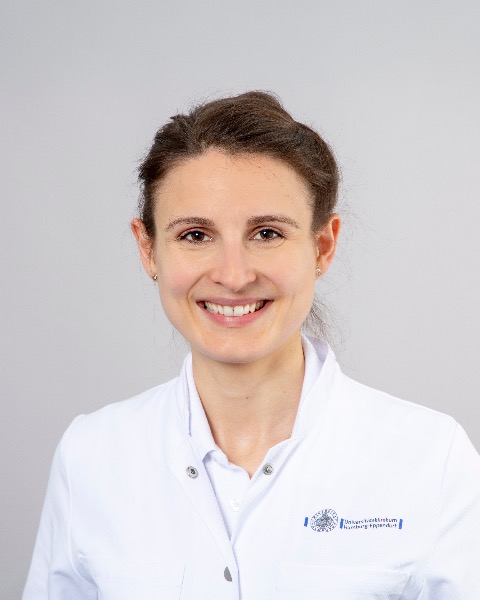Oral Abstract Session
OA – 18: Association of Cardiac biomarkers and Adverse Events with a Carfilzomib-containing Quadruplet in High-risk Newly Diagnosed Multiple Myeloma Patients: Correlative Program of the GMMG-CONCEPT Trial
Friday, September 27, 2024
10:48 AM - 11:00 AM East Coast USA Time
Location: Rio de Janeiro Ballroom, Lagune Barra Hotel

Lisa B. Leypoldt, MD (she/her/hers)
Clinician Scientist/ Research Fellow
University Medical Center Hamburg-Eppendorf, Germany / Dana-Farber Cancer Institute, Boston, MA, USA
Hamburg, Germany
Speaker(s)
Introduction: Cardiovascular adverse events (CVAE) are clinically relevant side effects of the proteasome inhibitor carfilzomib (K). In the GMMG-CONCEPT study (NCT03104842), K-based quadruplet is given as first-line treatment with isatuximab, lenalidomide, and dexamethasone (Isa-KRd) in induction (IND) and consolidation (CONS) of high-risk (HR) multiple myeloma (MM) patients (pts). Transplant-eligible pts undergo high-dose melphalan intensification (INTENS), all pts receive 2 years Isa-KR maintenance (MAIN).
Methods:
Pts were eligible for this correlative study if a serum sample from inclusion and ≥1 later time point were available. High sensitive Troponin I (hs-TnI) indicating myocardial injury and N-terminal pro-b-type natriuretic peptide (NT-proBNP) reflecting hemodynamic stress were measured using immunoassays (Abbott) and are reported as medians with interquartile ranges. Time-to-event analyses were performed using Kaplan-Meier estimators; log-rank test was used for statistical analysis. The primary aim was to evaluate if NT-proBNP or hs-TnI were predictive of CVAE.
Results:
In total, 126 pts (median age 60 years) were included with 2-11 samples per pt. Overall, 48 (Kaplan-Meier estimator 42.3%) pts experienced any CVAE while on study; arterial hypertension was the most common (n=24, 19%). Most CVAEs occurred during the first 3 IND cycles and during MAIN.
The majority of pts (96/126, 76%) showed increased NT-proBNP levels ( >125 ng/l) before treatment initiation (median 229 ng/L [IQR, 129-503]). Pts with preexisting cardiovascular comorbidities (CVM; n=64) showed higher levels of NT-proBNP after INTENS (122 [92-353] vs 87 [62-136] ng/l, p=0.007) and during CONS (171 [84-574] vs 111 [58-190] ng/l, p=0.016) and MAIN (224 [115-379] vs 131 [56-186] ng/l, p=0.016) but not before treatment initiation or during IND compared to pts without CVM. Increased NT-proBNP levels at any time point were not predictive for occurrence of CVAE. NTproBNP levels during MAIN (224 [115-379] vs 131 [56-186] ng/l, p=0.008) were higher in pts who experienced a CVAE (n=48) compared to pts without.
In contrast to NT-proBNP, hsTropI levels were low at baseline (median 3.7 ng/L [IQR, 2.2-7.0]) and elevated above normal limits ( >26.2 ng/L) in only 4/126 pts (3%). Time-to-event analysis showed that pts with baseline hsTropI levels of ≥2.9 ng/L had a significantly higher risk of developing a CVAE during treatment vs pts with hsTropI levels < 2.9 ng/L (p=0.0059). In Cox regression analysis, an early change from baseline was associated with a slightly, but significantly elevated risk for new onset CVAE (hazard ratio 1.13 [1.02-1.24], p=0.017).
Conclusions: Elevated levels of NT-proBNP are common in newly diagnosed HR MM pts, but neither the baseline value nor an early change from baseline within the first 3 IND cycles are predictive for CVAEs. In contrast, hsTropI is rarely elevated, but baseline levels below < 2.9 ng/L were negative predictive for the occurrence of CVAE during Isa-KRd quadruplet treatment for high-risk MM.
Methods:
Pts were eligible for this correlative study if a serum sample from inclusion and ≥1 later time point were available. High sensitive Troponin I (hs-TnI) indicating myocardial injury and N-terminal pro-b-type natriuretic peptide (NT-proBNP) reflecting hemodynamic stress were measured using immunoassays (Abbott) and are reported as medians with interquartile ranges. Time-to-event analyses were performed using Kaplan-Meier estimators; log-rank test was used for statistical analysis. The primary aim was to evaluate if NT-proBNP or hs-TnI were predictive of CVAE.
Results:
In total, 126 pts (median age 60 years) were included with 2-11 samples per pt. Overall, 48 (Kaplan-Meier estimator 42.3%) pts experienced any CVAE while on study; arterial hypertension was the most common (n=24, 19%). Most CVAEs occurred during the first 3 IND cycles and during MAIN.
The majority of pts (96/126, 76%) showed increased NT-proBNP levels ( >125 ng/l) before treatment initiation (median 229 ng/L [IQR, 129-503]). Pts with preexisting cardiovascular comorbidities (CVM; n=64) showed higher levels of NT-proBNP after INTENS (122 [92-353] vs 87 [62-136] ng/l, p=0.007) and during CONS (171 [84-574] vs 111 [58-190] ng/l, p=0.016) and MAIN (224 [115-379] vs 131 [56-186] ng/l, p=0.016) but not before treatment initiation or during IND compared to pts without CVM. Increased NT-proBNP levels at any time point were not predictive for occurrence of CVAE. NTproBNP levels during MAIN (224 [115-379] vs 131 [56-186] ng/l, p=0.008) were higher in pts who experienced a CVAE (n=48) compared to pts without.
In contrast to NT-proBNP, hsTropI levels were low at baseline (median 3.7 ng/L [IQR, 2.2-7.0]) and elevated above normal limits ( >26.2 ng/L) in only 4/126 pts (3%). Time-to-event analysis showed that pts with baseline hsTropI levels of ≥2.9 ng/L had a significantly higher risk of developing a CVAE during treatment vs pts with hsTropI levels < 2.9 ng/L (p=0.0059). In Cox regression analysis, an early change from baseline was associated with a slightly, but significantly elevated risk for new onset CVAE (hazard ratio 1.13 [1.02-1.24], p=0.017).
Conclusions: Elevated levels of NT-proBNP are common in newly diagnosed HR MM pts, but neither the baseline value nor an early change from baseline within the first 3 IND cycles are predictive for CVAEs. In contrast, hsTropI is rarely elevated, but baseline levels below < 2.9 ng/L were negative predictive for the occurrence of CVAE during Isa-KRd quadruplet treatment for high-risk MM.